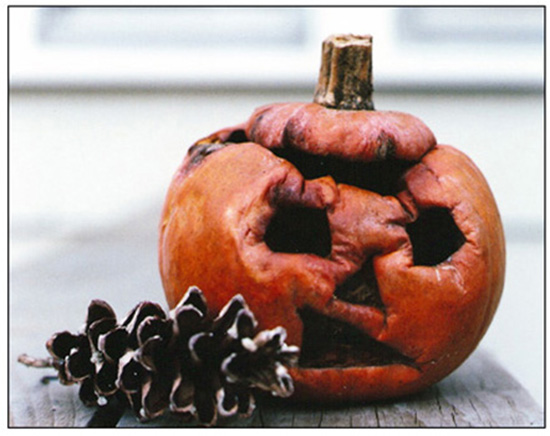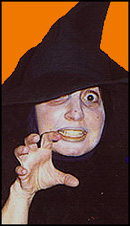| HOME |
 |
 |
First off, there were no outdoor decorations to mark the holiday, except for an occasional pumpkin on the porch. Folks who did that were taking a chance because mischief was much more common in those days — things such as draping trees with toilet paper, soaping windows, throwing eggs, putting dog crap on front doorsteps in paper bags that occasionally were set on fire (to be stomped out by the unfortunate person who answered the doorbell) . . . and, of course, destroying those pumpkins that had been placed on the porch. IN SOLVAY, NY, where I grew up, we didn’t say “Trick or Treat!” Residents weren’t given an option. We yelled, “Hotchee-botchee, GIVE me something to eat!” Naturally, we referred to this Halloween ritual as hotchee-botcheeing. We’d often do it twice — on October 31 and the next night . . . because we knew there still were sweets to be had. (There is a tiny controversy among Solvay oldtimers about what we actually said. All I know is that on our street, the one and only Russet Lane, we said "Hotchee-botchee!" Not "argle bargle" or "Harchy Warchy" or whatever else some people remember.) Much of what we received was homemade — cupcakes and popcorn balls were popular — and apples were common. Some neighbors became known for their specialty. This was a nice Halloween tradition that soon would be lost. We had no fear of tainted treats. That would happen when we became parents. Most significant, perhaps, is that kids didn’t go hotchee-botcheeing until they were of school age and unafraid to walk in dark streets with their friends. We covered a small range — the 14 houses on our one-block Russet Lane and, if we were adventuresome, we’d go around the block and return via a path along the edge of the park at the top of our street. Only a few kids from other streets showed up in those days. And no children were accompanied by adults, who stayed home for what might seem conflicting reasons. One, they trusted the older kids to watch out for the younger, but, two, they were wary the older kids might instigate some of that mischief. In other words, on Halloween it was their house, not their children, that needed protection. BY THE TIME I went off to college in the mid-1950s, younger children had gotten into the act, some parents were in evidence as chaperons, and routes were expanded to include several streets. My parents even noticed a few kids being driven onto Russet Lane. Soon afterward came the awful razor blade scare. Apples were out, so were homemade goodies. More and more candy was specially packaged and marketed for Halloween. Skeletons, witches, bats and pumpkins decorated many homes. More and more adults who stayed home to hand out treats did so in costume. When my first two children, Jeff and Laura, started trick-or-treating in Rhode Island, I accompanied them, their mother was stuck at home to deal with an ever-increasing number of candy lovers. The treat-giving operation became more and more efficient. People removed storm windows from their outer door and so they could hand out treats with that door shut. They did so from large bowls or baskets into which they had deposited all of the candy purchased for the occasion. Some kids started negotiating for treats, but few lingered to chat about their costumes, they were too much in a hurry to continue their rounds, some going first to parents waiting at the curb to inspect treats their children had just received. At times there were 20 children lined up behind the two or three on your doorstep. Pranks were few and far between and almost always were played on neighbors whose homes were dark because they had gone out for the evening to avoid young visitors. AFTER MY FIRST wife and I were divorced, Jeff and Laura entered a period of double holidays. On Halloween, for example, they went trick-or-treating in two neighborhoods, one in Warwick, the other in Cranston, and along the way accumulated a sinful amount of candy. I’ll never forget the time Jeff stuffed a pillowcase full of Halloween loot into a cookie tin and slid it under his bed for future consumption — then, amazingly, forgot about it until the following October 31. When he pried the lid off that cookie tin we were hit by the overpowering scent of bubble gum which had penetrated all of the other candy inside.
As always, I walked the streets with Jeff and Laura, now with the youngest, Meridith, in tow. We were standing in front of a house where the man handing out candy was putting on quite a show as Count Dracula. Some kids were hesitant to approach the front door, but one who had just received his treat came walking toward the street assuring them, “Hey, this guy is nothing . . . but don’t go to that house up on Mayfield. There’s a witch who answers the door – and she’s really scary!” IN THOSE DAYS we'd greet about 140 trick-or-treaters. One year we ran out of candy and had to tap the private reserve — full-sized candy bars. So a year later we loaded up on those bite-sized versions . . . and abruptly the holiday changed. As the evening went by my wife started giving out treats by the handful. The boys and girls who had gotten too old for the holiday hadn't been replaced by a new generation. This would soon become apparent in the local schools where enrollment dropped faster than the stock market had in 1929. Also, church and community groups began promoting Halloween activities to discourage trick-or-treating. A nearby outdoor shopping mall got into the act. Halloween had become very organized. We no longer called upon Mrs. Blackwell. By the time I retired in 2001 were we down to about 20 trick-or-treaters, almost all of them toddlers who arrived at our doorstep before 7 p.m. WE NOW LIVE in Bluffton, SC, in a gated community where kids are allowed to trick-or-treat until 8 p.m., but few show up after 7, some of them start while it is still daylight. Our treats must include candy that contains no nuts. Children who are allergic are taught to issue advisories. Trick-or-treaters outnumber the adults, but barely. The most popular houses are the ones most decorated. As you’ve probably noticed in your neighborhood, Halloween decorating now rivals Christmas, thanks to those inflatable objects, from giant ghosts to mammoth spiders and pumpkins that could be floats in the Macy’s Thanksgiving Day Parade. There are occasional acts of vandalism, but nothing compared with the past. My hunch is that back in the 1940s only few of these inflatable creatures would have remained in place until October 31. Tricks are out, treats are in. My wife and I have been impressed with how cute and polite the children are in Bluffton. Older trick-or-treaters have engaged us in amusing conversations, tempting us to unretire Mrs. Blackwell. However, today’s trick-or-treaters also include infants who are costumed and carried by their parents from house to house. Being confronted by Mrs. Blackwell could scar them for life. When it comes to trick-or-treating these days, it's better to be safe than scary |
| HOME • CONTACT |

